Birth certificate
A birth certificate is a vital record that documents the birth of a person. The term "birth certificate" can refer to either the original document certifying the circumstances of the birth or to a certified copy of or representation of the ensuing registration of that birth. Depending on the jurisdiction, a record of birth might or might not contain verification of the event by such as a midwife or doctor.
History and contemporary times
The documentation of births is a practice widely held throughout human civilization, especially in China, Egypt, Greece, Rome, and Persia. The original purpose of vital statistics was for tax purposes and for the determination of available military manpower. In England, births were initially registered with churches, who maintained registers of births. This practice continued into the 19th century.[1] The compulsory registration of births with the United Kingdom government is a practice that originated at least as far back as 1853.[2] The entire United States did not get a standardized system until 1902.[3]
Most countries have statutes and laws that regulate the registration of births. In all countries, it is the responsibility of the mother's physician, midwife, hospital administrator, or the parent(s) of the child to see that the birth is properly registered with the appropriate government agency.
The actual record of birth is stored with a government agency. That agency will issue certified copies or representations of the original birth record upon request, which can be used to apply for government benefits, such as passports. The certification is signed and/or sealed by the registrar or other custodian of birth records, who is commissioned by the government.
The right of every child to a name and nationality, and the responsibility of national governments to achieve this are contained in Articles 7 and 8 in the United Nations Convention on the Rights of the Child: "The child shall be registered immediately after birth and shall have the right from birth to a name, the right to acquire a nationality..." (CRC Article 7) and "States Parties undertake to respect the right of the child to preserve his or her identity, including nationality, name and family relations..." (CRC Article 8).[4]
...it's a small paper but it actually establishes who you are and gives access to the rights and the privileges, and the obligations, of citizenship.
Despite 191 countries ratifying the Convention, the births of millions of children worldwide go unregistered. By their very nature, data concerning unregistered children are approximate. About 29% of countries don't have available or sufficient data to assess global progress towards the SDG goal of universal coverage.[6] However, from the data that is available, UNICEF estimates that more than a quarter of children under 5 worldwide are unregistered.[7] The lowest levels of birth registration are found in sub-Saharan Africa (43 percent). This phenomenon disproportionately impacts poor households and indigenous populations. Even in many developed countries, it contributes to difficulties in fully accessing civic rights.[8]
Birth registration opens the door to rights to children and adults which many other human beings take for granted: to prove their age; to prove their nationality; to receive healthcare; to go to school; to take exams; to be adopted; to protection from under-age military service or conscription; to marry; to open a bank account; to hold a driving licence; to obtain a passport; to inherit money or property; and to vote or stand for elected office.[9]
There are many reasons why births go unregistered, including social and cultural beliefs and attitudes; alternative documents and naming ceremonies; remote areas, poor infrastructure; economic barriers; lack of office staff, equipment and training; legal and political restrictions; fear of discrimination and persecution; war, conflict and unrest or simply the fact that there is no system in place.[9][10][11][12][13][14]
Retrospective registration may be necessary where there is a backlog of children whose births have gone unregistered. In Senegal, the government is facilitating retrospective registration through free local court hearings and the number of unregistered children has fallen considerably as a result. In Sierra Leone, the government gave the National Office of Births and Deaths special permission to issue birth certificates to children over seven. In Bolivia, there was a successful three-year amnesty for the free registration of young people aged between 12 and 18.[15]
Statelessness, or the lack of effective nationality, impacts the daily lives of some 11–12 million people around the world. Perhaps those who suffer most are stateless infants, children, and youth. Although born and raised in their parents' country of habitual residence, they lack formal recognition of their existence.[16]
Australia
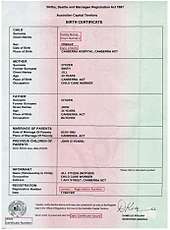
States and territories of Australia are responsible for the issuance of birth certificates, through agencies generally titled "Registry of Births Deaths and Marriages" or similar.[17]
Initially registering a birth is done by a hospital through a "Birth Registration Statement" or similar, signed by appropriately licensed and authorized health professionals, and provided to the state or territory registry. Home births are permitted, but a statement is required from a registered midwife, doctor or 2 other witnesses other than the parent(s). Unplanned births require in some states that the baby be taken to a hospital within 24 hours.[18] Once registered, a separate application (sometimes it can be done along with the Birth Registration Statement) can be made for a birth certificate, generally at a cost. The person(s) named or the parent(s) can apply for a certificate at any time.[19] Generally, there is no restriction on re-applying for a certificate at a later date, so it could be possible to legally hold multiple original copies.
The Federal government requires that births be also registered through a "Proof of Birth Declaration" similarly signed as above by a doctor or midwife. This ensures the appropriate benefits can be paid, and the child is enrolled for Medicare.[20]
The state or territory issued birth certificate is a secure A4 paper document, generally listing: Full name at birth, sex at birth, parent(s) and occupation(s), older sibling(s), address(es), date and place of birth, name of the registrar, date of registration, date of issue of certificate, a registration number, with the signature of the registrar and seal of the registry printed and or embossed. Most states allow for stillbirths to be issued a birth certificate. Some states issue early pregnancy loss certificates (without legal significance if before 20 weeks).[21] Depending on the state or territory, amendment on the certificate are allowed to correct an entry, add ascendant, recognize same-sex relationship,[22] changing the sex of the holder is also permitted in some state or territory.[23]
The full birth certificate in Australia is an officially recognized identity document generally in the highest category.[24] The birth certificate assists in establishing citizenship. Shorter and/or commemorative birth certificates are available; however, they are not generally acceptable for identification purposes.[25]
Birth certificates in Australia can be verified online by approved agencies through the Attorney-General's Department Document Verification Service[26] and can be used to validate identity digitally, e.g. online.
Canada
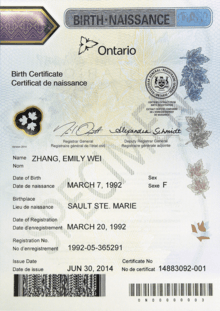
In Canada, the issuance of birth certificates is a function of the provinces and territories. In 2008, provinces and territories started rolling out new polymer certificates to new applicants.[27][28]
Canadian birth certificates may be obtained from the following:
- Alberta – A registry agent authorised by the Province
- British Columbia – British Columbia Vital Statistics Agency
- Manitoba – Manitoba Vital Statistics Agency
- New Brunswick – Service New Brunswick
- Newfoundland and Labrador – Service NL
- Northwest Territories – Health Services Administration Office
- Nova Scotia – Access Nova Scotia
- Nunavut – Registrar-General of Vital Statistics
- Ontario – ServiceOntario
- Prince Edward Island – Vital Statistics Registry
- Quebec – Director of Civil Status (Directeur de l'etat civil)
- Saskatchewan – eHealth Saskatchewan
- Yukon – Vital Statistics, Government of Yukon
Types issued
There are three forms of birth certificates issued:
- Certified true copy/photostat – contains all information available on the birth of a person.
- Long-form – contains name, place and date of birth, parental information, date of issue, date of registration, registration number, certificate number, and authorised signature(s).
- Short-form – as with long-form, except for parental information.
Residents of Quebec born elsewhere can have their non-Quebec birth record inserted into Quebec's birth register. Quebec birth certificates issued with regard to a birth, civil union, marriage or death that occurred outside of Quebec are referred to as "semi-authentic" under paragraph 137 of the Civil Code of Québec, until their full authenticity is recognised by a Quebec court.[29] Inserting one's birth record into the Quebec register is a prerequisite for anyone born outside of Quebec to apply for a legal name change in the province. Semi-authentic birth certificates are issued in the long-form only.
Languages
Depending on the province, certificates are in English, French or both languages. Birth certificates from Canadian territories are in English and French, as well as Inuktitut in Nunavut (though individual data is in the Roman alphabet only, not in Inuktitut syllabics).
China
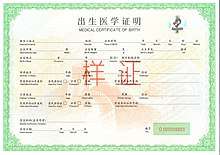
The People's Republic of China issued its first medical birth certificate on 1 January 1996. Persons born prior to that date can obtain a birth certificate from a Chinese notary public by way of presenting their hukou and other supporting documents. The notary then proceeds to issue a notarial birth certificate based on the information contained in the said documentation. This notarial birth certificate is acceptable for immigration purposes.[32]
The fifth-generation medical birth certificate was adopted nationwide on 1 January 2014.[33] Still, China is amongst those countries with no globally comparable data, presenting challenges to researchers who wish to assess global and regional progress towards universal birth registration.[6]
Czech Republic
The Czech Republic maintains a registry of vital records, including births, of people, regardless of nationality, or birthplace. Every citizen of the Czech Republic will need to register their birth if born abroad, effectively granting a foreign born person two birth certificates. The Czech Republic will also register foreigners in some cases. The office that registers births is colloquially called 'matrika'.
France
Civil records in France have been compulsory since the 1539 ordinance of Villers-Cotterêts, in which the King Francis I ordered the parishes to record baptisms, marriages and sepultures. Then in 1667 the parishes were asked to issue two registers in two different places in order to avoid the loss of data. Jews and Protestants were allowed to have their own records by Louis XVI in 1787. In 1792, the registers were fully secularized (birth, civil marriage and death replaced baptism, religious marriage and sepulture, plus an official kept the records instead of a priest), and the Code civil did create the compulsory birth certificate in 1804 (in its articles 34, 38, 39 et 57).[34] This document should be completed at one's marriage since 1897, at one's divorce since 1939, at one's death since 1945 and at one's civil union since 2006. A note is added on the certificate for all these events.
Hong Kong
In Hong Kong, the system is similar to England and Wales, wherein the government keeps a birth register book, and the birth certificate is actually a certified copy of the birth register book entry[35] .
Currently, the Immigration Department is the official birth registrar. All parents need to register their children's birth within 42 days.[36] Birth certificates issued between 1 July 1997 and 27 April 2008 recorded whether or not the child's Hong Kong permanent resident status was established at birth. Birth certificates issued after the latter date record which provision of the Immigration Ordinance the said status has been established under.[37]
India
Traditionally births were poorly recorded in India.[38]
For official purposes, other proofs are accepted in India in lieu of the birth certificate, such as matriculation certificates.[39] Facilities are available to produce a birth certificate from a passport.[40]
By law since 1969, registration of births is compulsory as per provisions of Registration of Births & Deaths Act.[41] Birth certificates are issued by the Government of India or the municipality concerned. Specific rules vary by state, region and municipality.
In Delhi, for example, births must be registered within 21 days by the hospital or institution, or by a family member if the birth has taken place at home. After registration, a birth certificate can be obtained by applying to the relevant authority. Certificates can also be issued under special provisions to adopted children, and undocumented orphans. Overseas births can also be registered.[41]
Some municipalities, such as the Greater Chennai Corporation allow for fully digital birth certificates to be applied for, printed, and verified online.[42]
Indonesia

In Indonesia, local civil registries are responsible for issuing birth certificates (akta kelahiran).
The current legislation governing the registration of births within Indonesia is the 2006 Act 23 on the Administration of Civil Status (UU No. 23 Tahun 2006 tentang Administrasi Kependudukan), as amended by 2013 Act 24 on Amendments to 2006 Act 23.[43][44][45]
The following Staatsbladen (state gazettes), enacted by the Dutch colonial government, were supplanted by the Act:
- 1849 Staatsblad 25 for persons of European descent
- 1917 Staatsblad 130 for persons of Chinese descent
- 1920 Staatsblad 751 for persons of Indigenous descent
- 1923 Staatsblad 75 for persons of Indigenous descent professing the Christian faith
Prior to 1986, persons not born in any of the above groups had to be registered through court order. This changed by a 1986 decree of the Minister of Home Affairs, resulting in a jolt in the number of births being registered. In 1989, a subsequent decree was effected by the Minister, allowing those born between 1986 and 1989 to have their births registered.[45]
There are several types of birth certificates issued to Indonesian-born individuals, per the Denpasar Civil Registry:[46]
- General Birth Certificate (Akta Kelahiran Umum)
- Delayed Birth Certificate (Akta Kelahiran Terlambat)
- Birth Certificate for a Child Born to a Single Mother (Akta Kelahiran Anak Seorang Ibu)
Pursuant to the Act's domicile principle, a birth certificate is issued by the Civil Registry of the parents' home prefecture or city, as determined from their Indonesian identity card. This is not always the same place as the actual prefecture or city of birth of the child.
There is no such thing as a certified copy of the original birth registration form; all Indonesian birth certificates are abstracts in nature and list an individual's nationality, name, place and date of birth, birth order, parents' names and marital status only.
In 2019, Indonesian local civil registries began to issue birth certificates with QR codes in lieu of the traditional authenticating signature and stamp. Widodo, director of civil registry services for the Bengkulu Civil Registry, is quoted as saying that "this is by decree of the Minister of Home Affairs, and will help simplify things for the general public as they will no longer be required to go through the hassle of getting [birth certificates] legalised." [47][48]
Japan
In Japan, the household registration document (jp: 戸籍, koseki) is generally used in lieu of a birth certificate.
Since a koseki acts as proof of Japanese citizenship, only Japanese citizens may be registered on one. Non-Japanese citizens born in Japan can obtain a Certificate of Matters Stated In a Written Notification (jp: 出生届記載事項証明書, shussei todoke kisai jiko shomeisho). A Certificate of Matters Stated In a Written Notification may be obtained from the city/ward/town office the birth was reported to, and is the equivalent of a birth certificate.
This is to be distinguished from a Certificate of Acceptance of Birth Notification (jp: 出生届受理証明書, shussei todoke juri shomeisho), which, according to the Australian Embassy at Tokyo, only constitutes a receipt proving that a birth registration has been lodged with a city/ward/town office.[49][50]
Malaysia
In Malaysia, the National Registration Department (Jabatan Pendaftaran Negara) is responsible for the registration of births, and for issuing birth certificates (sijil kelahiran).
In 2011, the Department started colour-coding birth certificates. Henceforth, citizens at birth would receive a pale-green birth certificate, while those who do not acquire Malaysian citizenship at birth would be given a red birth certificate. Then-director Datin Jariah Mohd Said was reported as saying that "it [would] address the wrong impression among foreign parents that their children automatically become Malaysians by virtue of them having the pale green certificate." [51]
New Zealand
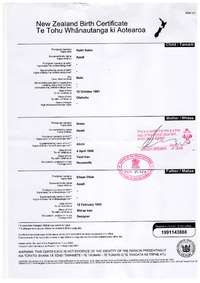
The Department of Internal Affairs is responsible for issuing birth certificates in New Zealand.[52][53] Certain historical records including historical birth certificates are available online in a searchable format on the Birth, Death and Marriage Historical Records website. The available records are for births recorded at least one hundred years ago.
Citizenship information is recorded on New Zealand birth certificates for births after 2005, as this was when the country formally ended its practice of jus soli.[54]
Russia
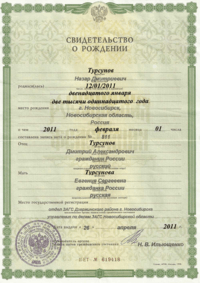
Russian birth certificates were previously issued in a booklet format, similar to that of internal passports; today, they are issued on numbered and watermarked A4 security paper. They are typically issued in the Russian language only; however, if a birth is recorded in one of the Russian republics with federal subject status, the resulting birth certificate may be bilingual (Russian and the official language of the said republic).[55][56][57]
Filling a birth certificate
A Russian birth certificate may either be filled out in type or print. It is then signed and sealed by a qualified officer of the public authority issuing the certificate (a local civil registry or Russian overseas mission). By default, information on the parents' ethnic origins is no longer recorded – however, it may be recorded upon request.
Obtaining a birth certificate
A Russian birth certificate may be applied for by the person named on the certificate if they are of full age, their parents if still vested with parental rights, their guardian(s) and/or caregiver(s). If the certificate is lost, the public authority that issued the original document issues a replacement on application.
Sweden
Sweden no longer issues birth certificates. Instead, the Swedish Tax Agency will issue a Personbevis (Extract from the Population Register) for individuals born in Sweden. This takes the place of both birth and marriage certificates for international purposes. The Extract contains, inter alia, place and date of birth, parental information, marriage status, and current registered address.[58]
United Kingdom

England and Wales
In England and Wales, the description "birth certificate" is used to describe a certified copy of an entry in the birth register.[59]
Civil registration of births, marriages and deaths in England and Wales started on 1 July 1837.[60] Registration was not compulsory until 1875, following the Registration of Births and Deaths Act 1874, which made registration of a birth the responsibility of those present at the birth.[61]
When a birth is registered, the details are entered into the register book at the local register office for the district in which the birth took place and is retained permanently in the local register office. A copy of each entry in the birth register is sent to the General Register Office (GRO).[62]
Pre-1837 birth and baptism records
Before the government's registration system was created, evidence of births and/or baptisms (and also marriages and death or burials) was dependent on the events being recorded in the records of the Church of England or in those of other various churches – not all of which maintained such records or all types of those records. Copies of such records are not issued by the General Register Office; but can be obtained from these churches, or from the local or national archive, which usually now keeps the records in original or copy form.
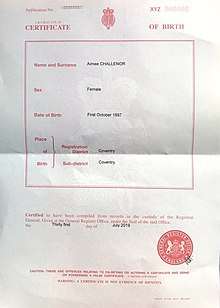
Types of certified copies issued in England and Wales
There are two types of birth certificates:
A long-form certificate is a copy of the original entry in the birth register, giving all the recorded details.[63] Information includes; name, sex, date, and place of birth of the child, father's name, place of birth and occupation, mother's name, place of birth, maiden name, and occupation. Certificates for births before 1911 do not show the mother's maiden name, before 1969 do not show the detail(s) of the parent(s), place of birth and registration, and before 1984 do not show mother's occupation.[64]
A short-form certificate shows the child's full name, sex, date, and place of birth. It does not give any detail(s) of the parent(s); it is therefore not proof of parentage.[63]
Both versions of a certificate can be used in the verification of identity by acting as a support to other information or documentation provided. Where proof of parentage is required only a full certificate will be accepted.[65]
The original registrations are required by law[66] to be issued in the form of certified copies to any person who identifies an index entry and pays the prescribed fee. They can be ordered by registered users from the General Register Office Certificate Ordering Service or by postal or telephone ordering from the General Register Office or by post or in person from local registrars. If the birth was registered within the past 50 years, detailed information is required before a certificate will be issued.[67]
The General Register Office draws on several registers for the issuance of birth certificates: the Register of Live Births, the Register of Stillbirths, the Abandoned Children Register, the Adopted Children Register, the Parental Order Register,[68] and the Gender Recognition Register (for holders of Gender Recognition Certificates).[69]
Northern Ireland
In Northern Ireland, the General Register Office Northern Ireland (GRONI) records births and stillbirths occurring in Northern Ireland.[70]
Scotland
The National Records of Scotland maintains records of all births occurring in Scotland.[71]
United States
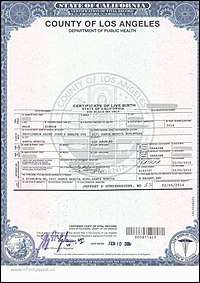
In the U.S., the issuance of birth certificates is a function of the Vital Records Office of the states, capital district, territories[72] and former territories.[73] Birth in the U.S. establishes automatic eligibility for American citizenship, so a birth certificate from a local authority is commonly provided to the federal government to obtain a U.S. passport.[74][75] However, the U.S. State Department does issue a Consular Report of Birth Abroad for children born to U.S. citizens (who are also eligible for citizenship), including births on military bases in foreign territory.[76]
The federal and state governments have traditionally cooperated to some extent to improve vital statistics. From 1900 to 1946 the U.S. Census Bureau designed standard birth certificates, collected vital statistics on a national basis, and generally sought to improve the accuracy of vital statistics. In 1946 that responsibility was passed to the U.S. Public Health Service. Unlike the British system of recording all births in "registers", the states file an individual document for each and every birth.[77]
The U.S. National Center for Health Statistics creates standard forms that are recommended for use by the individual states to document births. However, states are free to create their own forms.[78] As a result, neither the appearance nor the information content of birth certificate forms is uniform across states. These forms are completed by the attendant at birth or a hospital administrator, which are then forwarded to a local or state registrar, who stores the record and issues certified copies upon request.[1]
Birth certificates for individuals born in or adopted to the United States
According to the Department of Health and Human Services, Office of Inspector General, as of 2000 there were more than 6,000 entities issuing birth certificates. The Inspector General report states that according to the staff at the Immigration and Naturalization Service's Forensics Document Laboratory the number of legitimate birth certificate versions in use exceeded 14,000.[79]
Short-form birth certificates and acceptance thereof
In the case of applying for a U.S. passport, not all legitimate government-issued birth certificates are acceptable:
A certified birth certificate has a registrar's raised, embossed, impressed or multicolored seal, registrar's signature, and the date the certificate was filed with the registrar's office, which must be within 1 year of your birth. Please note, some short (abstract) versions of birth certificates may not be acceptable for passport purposes.
Beginning April 1, 2011, all birth certificates must also include the full name of the applicant's parent(s).[80]
The U.S. State Department has paid close attention to abstract certificates from both Texas and California. There have been reports of a high incidence of midwife registration fraud along the border region between Texas and Mexico,[81][82] and the Texas abstract certificate form does not list the name or occupation of the attendant. The California Abstract of Birth did not include an embossed seal, was no longer considered a secure document, and have not been issued in California since 2001.[83]
Souvenir birth certificates
Most hospitals in the U.S. issue a souvenir birth certificate which may include the footprints of the newborn. However, these birth certificates are not legally accepted as proof of age or citizenship, and are frequently rejected by the Bureau of Consular Affairs during passport applications. Many Americans believe the souvenir records to be their official birth certificates when in reality they hold little legal value.[84][85]
Adoptive birth certificates
When an adoption is finalized, a U.S. jurisdiction typically seals the original birth certificate. In its place, a replacement birth certificate is issued, with the adoptee's new name and adoptive parents listed. Some jurisdictions allow adopted adopted persons unrestricted access to the original birth certificate. Some only make such available upon permission of the biological parent(s) or an approved court petition. Finally, some jurisdictions do not make the original birth certificate available under any circumstances.[86]
U.S. jurisdictions also typically issue a Certificate of Foreign Birth, that serves as documentary evidence of birth of an overseas-born intercountry adoptee and their relationship to their adoptive United States parents; however, these certificates cannot serve as evidence of U.S. citizenship and must be supplemented by another document, such as a USCIS-issued Certificate of Citizenship.[87][88]
In 2018, the Colorado Department of Revenue declined Alisha Ann Haimei Heater's application for a learner's permit, because her Colorado-issued Certificate of Foreign Birth only proved date of birth and not lawful presence. When Heater was adopted in 2000, the Immigration and Naturalization Service had not automatically issued her a Certificate of Citizenship.[89]
Consular reports of birth for individuals born overseas
The Department of State currently issues form FS-240, formally known as the Consular Report of Birth Abroad of a Citizen of the United States of America. The report serves as prima facie documentary evidence of the acquisition of United States citizenship or non-citizen nationality at birth; however, the Foreign Affairs Manual of the Department makes it clear that the report is only supplementary to, and does not substitute for a locally-issued birth certificate. The Department contends that the issuance of birth certificates is a function that is expressly reserved to local vital statistics authorities and may not be assumed by a consular officer.[90]
However, prior to 1990, the Vital Records Section of the Department's Passport Services office was indeed responsible for certifying American births overseas, and issued FS-545 and DS-1350 (both officially titled Certification of Birth).
See also
- Birth registration in ancient Rome
- Birth registration campaign in Liberia
- Closed adoption
- Death certificate
- Identity card
- Marriage certificate
- Marriage license
- Passport
- Vital record
References
- Vital Records Registration Handbook Archived 11 April 2008 at the Wayback Machine (Jacksonville, FL: Florida Office of Vital Statistics, 2007) 7.
- "About Us" Archived 1 August 2008 at the Wayback Machine (UK General Registry Office). Retrieved August 2009, .
- Brumberg, H.L.; Dozor, D.; Golombek, S.G. (June 2012). "History of the birth certificate: from inception to the future of electronic data". Journal of Perinatology. 32 (6): 407–411. doi:10.1038/jp.2012.3. PMID 22301527.
- Convention on the Rights of the Child Archived 11 June 2010 at the Wayback Machine (Office of the United Nations High Commissioner for Human Rights, 1989). Retrieved 17 May 2011.
- Universal Birth Registration — A Universal Responsibility (Woking: Plan International, 2005)
- "Progress for Every Child in the SDG Era". UNICEF. 6 March 2018.
- "UNICEF Data – Birth Registration" (data.unicef.org) accessed 18 April 2018.
- Paula Gerba, "Making Indigenous Australians 'disappear': Problems arising from our birth registration systems," Alternative Law Journal 34, no. 3 (2009): |157–162, .
- Count Every Child (Plan, 2009).
- The 'Rights' Start to Life, (New York: UNICEF).
- "Fact sheets," (International Council of Nurses, 21 May 2010).
- UNICEF (2007) Birth Registration and Armed Conflict, Archived 6 July 2011 at the Wayback Machine (Florence: Innocenti Research Centre, 2007).
- Inter-Agency Task Team (IATT) on Children and HIV and AIDS Working Group on Civil Registration, Birth and Death Registration in the Context of HIV and AIDS in Eastern and Southern Africa: Human's First and Last Right (Plan, 2008).
- "Birth Registration: A Topic Proposed for an Executive Committee Conclusion on International Protection," (United Nations High Commissioner for Refugees, 9 February 2010).
- Simon Heap and Claire Cody, "The Universal Birth Registration Campaign," Archived 19 July 2011 at the Wayback Machine Forced Migration Review, no. 32 (2009): 20–22.
- Futures Denied: Statelessness Among Infants, Children and Youth Archived 12 September 2010 at the Wayback Machine (Refugees International, 2008).
- "Births, deaths and marriages registries". australia.gov.au. Retrieved 27 January 2019.
- "Births". Bdm.nsw.gov.au. Retrieved 27 January 2019.
- "Birth certificate". Bdm.nsw.gov.au. 8 October 2018. Retrieved 27 January 2019.
- "When your baby arrives – Australian Government Department of Human Services". Humanservices.gov.au. 22 October 2018. Retrieved 27 January 2019.
- "Archived copy". Archived from the original on 10 March 2017. Retrieved 4 April 2017.CS1 maint: archived copy as title (link)
- "Archived copy". Archived from the original on 10 March 2017. Retrieved 4 April 2017.CS1 maint: archived copy as title (link)
- http://www.bdm.nsw.gov.au/Documents/apply-for-record-a-change-of-sex.pdf
- "Archived copy" (PDF). Archived from the original (PDF) on 4 April 2017. Retrieved 4 April 2017.CS1 maint: archived copy as title (link)
- http://www.bdm.nsw.gov.au/Pages/apply-for-certificates/commemorative-certificates.aspx#CommemorativeBirthCertificate
- "About DVS". Dvs.gov.au. 15 May 2018. Retrieved 27 January 2019.
- "New Birth Certificate Design" (PDF).
- Please select all that apply (20 March 2017). "Personal Documents – Canada.ca". Servicecanada.gc.ca. Retrieved 27 January 2019.
- "Civil Code of Quebec".
- Immigration, Refugees and Citizenship Canada (30 September 2015). "Documents that prove your Canadian citizenship". aem. Retrieved 18 April 2020.
- "Calgary woman's Canadian birth certificate not recognized as proof of citizenship". Global News. Retrieved 18 April 2020.
- "What Type of China Birth Certificate Is Required for U.S. Immigration?". Chodorow Law Offices. 22 May 2019. Retrieved 18 April 2020.
- "Notification about initiating and standard management of new edition birth medical certificate issued by National Health and Family Planning Commission of the People's Republic of China and the Ministry of Public Security (Chinese)". National Health and Family Planning Commission of the People's Republic of China. Archived from the original on 6 April 2017. Retrieved 6 April 2017.
- "Legifrance translations | Légifrance, le service public de la diffusion du droit". www.legifrance.gouv.fr. Retrieved 26 October 2019.
- "Application for Search of Birth Records and/or a Certified Copy of a Birth Entry". Immigration Department, The Government of the Hong Kong Special Administrative Region. Retrieved 19 April 2019.
- "Registration of a Birth". Immigration Department, The Government of the Hong Kong Special Administrative Region. Retrieved 19 April 2019.
- "VSS Doctors' Guide – References and Appendices" (PDF).
- "25% of Indian births not registered". The Times of India. Retrieved 30 June 2017.
- "Passport Seva Application form". passportindia.gov.in. Retrieved 22 April 2017.
- "India Visa Information – Australia – Consular Miscellaneous Services – Issue of Birth Certificate – Basis Indian Passport". vfsglobal.com. Retrieved 22 April 2017.
Issuance of birth certificate to Indian nationals on the basis of valid Indian passport.
- "Department of Dte.of Economics & Statistics". delhi.gov.in. Government of NCT of Delhi. Archived from the original on 18 September 2014. Retrieved 22 April 2017.
- "Birth Certificates". chennaicorporation.gov.in. Greater Chennai Corporation. Retrieved 15 January 2018.
- "DISTRIBUSI IISALINANUNDANG-UNDANG REPUBLIK INDONESIANOMOR24 TAHUN2013TENTANGPERUBAHAN ATAS UNDANG-UNDANG NOMOR 23 TAHUN 2006TENTANG ADMINISTRASI KEPENDUDUKAN" (PDF). 2013.
- "Undang-Undang Nomor 23 Tahun 2006 tentang Administrasi Kependudukan" (PDF).
- "Perlunya Reformasi Pencatatan Kelahiran di Indonesia". hukumonline.com (in Indonesian). 24 April 2006. Retrieved 18 April 2020.
- (PDF) https://kependudukan.denpasarkota.go.id/new/public/ckfinder/userfiles/files/syarat-pencapilan.pdf. Missing or empty
|title=(help) - "Pencetakan Akta Kelahiran Gunakan HVS Dilengkapi Barcode | Terkini! Seputar Kota". Terkini! (in Indonesian). 6 March 2020. Retrieved 18 April 2020.
- "Lihat! Barcode di KK dan Akta Mulai Diterapkan di KBB". Jabar Ekspres Online (in Indonesian). 15 July 2019. Retrieved 18 April 2020.
- (PDF) https://japan.embassy.gov.au/files/seol/17%2001%20-%20CBD%20checklist%20-%20ENG.pdf. Missing or empty
|title=(help) - "Birth Certificate in Japan". legalization.tokyo. Retrieved 18 April 2020.
- "Dept adds colour to birth certs | The Star Online". The Star. Malaysia. Retrieved 18 April 2020.
- Births, Deaths, Marriages, and Relationships Registration Amendment Act 2008
- Birth, Death and Marriages website
- "Get proof you are a citizen". New Zealand Government. Retrieved 18 April 2020.
- http://legalru.ru/document.php?id=5081. Missing or empty
|title=(help) - "О ПОРЯДКЕ ОФОРМЛЕНИЯ И ВЫДАЧИ ВКЛАДЫША В СВИДЕТЕЛЬСТВО О РОЖДЕНИИ, ПОДТВЕРЖДАЮЩЕГО НАЛИЧИЕ У РЕБЕНКА ГРАЖДАНСТВА РОССИЙСКОЙ ФЕДЕРАЦИИ. Приказ. Министерство внутренних дел РФ (МВД России). 18.04.03 257. Предпринимательское право". businesspravo.ru. Retrieved 18 April 2020.
- "How to get a copy of your Russian birth certificate". Legal Beagle. Retrieved 18 April 2020.
- skatteverket.se, Skatteverket. "Information to foreign authorities". skatteverket.se. Retrieved 18 April 2020.
- Melanie Lee (14 January 2011). "GRO information on birth certificates in England and Wales" (PDF). whatdotheyno.com. General Registre Office. Retrieved 7 September 2015.
- "Civil Registration in England and Wales". genuki.org.uk. Retrieved 7 September 2015.
- "Registration of Births and Deaths Act 1874". Government of the United Kingdom. Retrieved 7 September 2015.
- "Official information on births, marriages and deaths". General Register Office. Archived from the original on 12 June 2006. Retrieved 7 September 2015.
- "Register a Birth". Government of the United Kingdom. 14 July 2015. Retrieved 8 September 2015.
- GRO (2015). "Information on a birth, marriage or death certificate". Government of the United Kingdom. Retrieved 8 September 2015.
- Treasury Solicitor's Department (10 March 2014). "Proof of Identity checklist for individuals". Government of the United Kingdom. Retrieved 8 September 2015.
- Births and Deaths Registration Act, 1953, 1 & 2 Eliz. 2, c. 1. Retrieved October 2011.
- GRO (2015). "Ordering a certificate for events which have taken place during the last 50 years". Government of the United Kingdom. Retrieved 8 September 2015.
- "Deed Poll Office (D·P·O)". Deed Poll Office. Retrieved 25 March 2020.
- https://www.tameside.gov.uk/Registrars/Gender-Recognition. Missing or empty
|title=(help) - "General Register Office for Northern Ireland". Government of the United Kingdom. Retrieved 18 April 2020.
- "Birth, death and marriage certificates in Scotland - mygov.scot". mygov.scot. Retrieved 18 April 2020.
- Birth Certificate Fraud (Office of Inspector General, U. S. Department of Health and Human Services, 1988), iii.
- Specifically, the Panama Canal Zone and Philippines.
- |Margaret Lee, U.S. Citizenship of Persons Born in the United States to Alien Parents, Congressional Research Service Report for Congress, (UNT Digital Library, 12 May 2006).
- Report of the panel to evaluate the standard U.S. certificates (Division of Vital Statistics National— Center for Health Statistics, April 2000, addenda November 2001), 60.
- Replace Your Vital Records: Get a Copy of Your Birth Certificate, USA.gov
- Report of the panel to evaluate the standard U.S. certificates (Division of Vital Statistics National— Center for Health Statistics, April 2000, addenda November 2001).
- 2003 Revisions of the U.S. Standard Certificates (Centers for Disease Control and Prevention, last updated 27 April 2011).
- Birth Certificate Fraud (Office of Inspector General, U. S. Department of Health and Human Services, 1988), 11.
- "First Time Applicants", US State Department. Retrieved 26 July 2011.
- "They Say They Were Born in the U.S.A. The State Department Says Prove It", The Wall Street Journal. Retrieved 11 January 2012.
- "NOTICE OF FINAL SETTLEMENT AGREEMENT IN A CLASS ACTION, Castellano, et al. v. Clinton, et al." Archived 21 May 2012 at the Wayback Machine, US State Department. Retrieved 11 January 2012.
- "FAQs – Birth, Death, and Marriage Services" Archived 9 May 2011 at the Wayback Machine, Santa Clara County – Office of the Clerk-Recorder. Retrieved 11 January 2012.
- authorFebruary 27, Diana C. Post; Pm, 2016 at 8:08 (3 January 2019). "Birth Certificate Translation for USCIS, Spanish to English | Southeast Spanish, Inc". Retrieved 2 November 2019.
- Bob Rankin, "Passports Online" on Ask Bob Rankin, 2006.
- "How can I get my Original Birth Certificate if I was adopted?". usbirthcertificates.com. Retrieved 13 March 2020.
- "Oregon Health Authority : Adoption: Foreign Born : Change Vital Records : State of Oregon". oregon.gov. Retrieved 18 April 2020.
- "36-338 – Certificates of foreign birth for adoptees". azleg.gov. Retrieved 18 April 2020.
- "Teen struggles to prove she's a legal citizen to Colorado DMV". KUSA. Retrieved 18 April 2020.
- "7 FAM 1440 CONSULAR REPORT OF BIRTH OF A CITIZEN/NON-CITIZEN NATIONAL OF THE UNITED STATES". fam.state.gov. Retrieved 18 April 2020.
| Wikimedia Commons has media related to Birth certificates. |